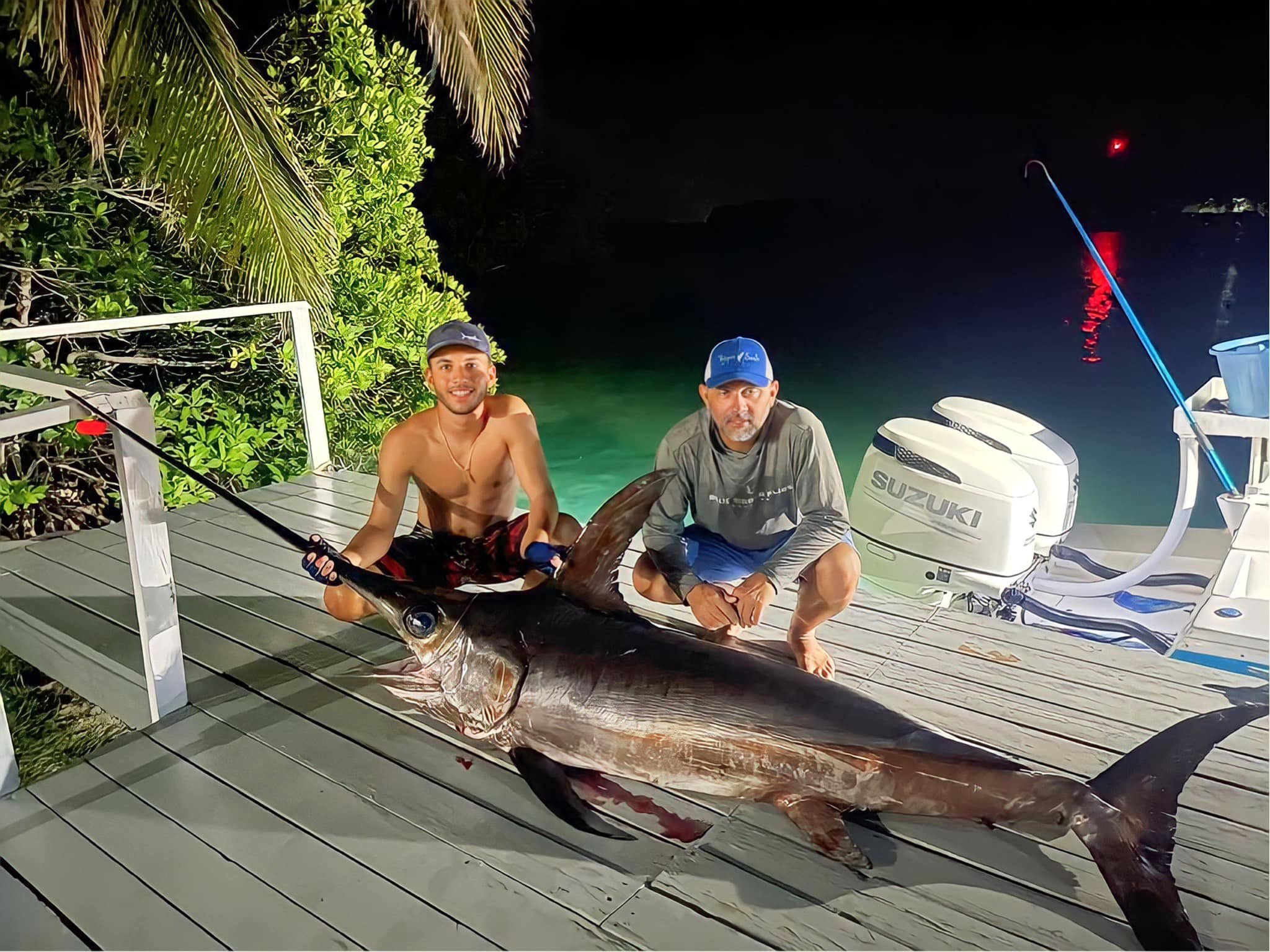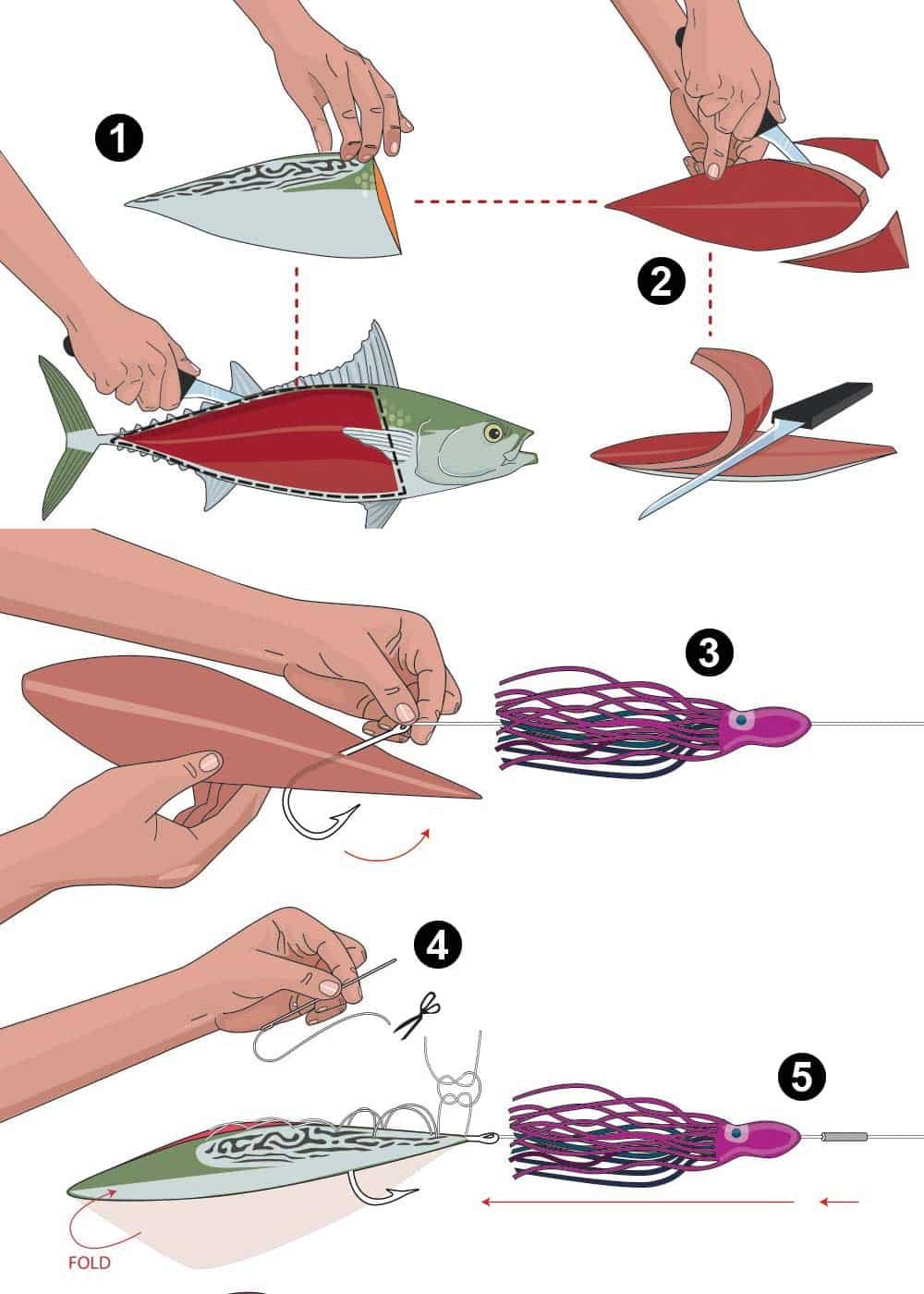Swordfishing in Belize: Belizean Crews Have Success Targeting Daytime & Nighttime Swordfish
Chunky, stocky, and powerfully built: the unmistakeable North Atlantic Swordfish is no longer just a rarity for anglers in Belize. Elusive still, yes, but as more of the sportfishing community of Belize targets swordfish through both daytime and nighttime, a handful of crews are sticking the landing. Whether by sheer luck on the electric reel or specialized technique, we hope you learn a little more about swordfishing in Belize by the end of this blog.
Rigging For Swordfish in Belize: Daytime vs. Nighttime Swordfishing
When feeding, a Swordfish rises from beneath a school of fish, swinging its sword from side to side, and striking at any fish within reach before consuming the stunned or dead prey. It’s here that the targeting technique differs. These neon-purple, world-traveling predators are primarily night feeders, coming closer to the surface and essentially, providing a larger window of opportunity for anglers. Catching swordfish at night was no longer a random bonus catch, but a planned effort. However, daytime swordfishing presents a brand-new challenge that’s closer to a finely tuned science.
That’s because daytime swordfishing involves the presentation of bait 1,000-2,000 feet below the surface. In most regions, this includes a wall of current you have to penetrate if you hope to get into the strike zone. Both daytime and nighttime swordfishing take current, similar bait, and heavy drag on hookup into consideration — but they’re different angles entirely. During the daytime, the swordfish bite is almost always a very subtle tap-tap or single solid thump. Training your eye to recognize the bite — over the methodical tip movement caused by the rocking boat — and reacting is a technique you’ll learn to master.
“Even though they’ve only been targeted for sportfishing, it’s still an untapped fishery,” BGFA President Madelyn Bowen says of the swordfishing in local waters.
But as daytime swordfishing sees anglers deploy a single bait to the bottom reaches of the water column fifteen hundred feet below the surface, nighttime swordfishing is much more hands-on and active, requiring the use of multiple rods, with multiple baits in the water simultaneously. While you can find life anywhere from 1,000 to 1,800 feet of water, the goal is to drift baits in the upper third of the water column across hills, depressions temperature breaks, and any bait readings. Along these changes in bottom contour, deep-water currents force nutrient-rich water toward the surface, a.k.a. the sweet spot for a sword strike. Do your research beforehand, take the weather conditions into account, and then find your precise speed and direction of drift. Going along with the prevailing current, you’ll set the drift to take you directly across the bottom. Once you’re on point and prepared to fish, deploy your farthest bait first, working your way toward the boat as you go (and even avoid tangles).
Father-son duo hook nighttime swordfish.
Pete & Matthew Codd hook their first swordfish in Belize within 800 feet of water aboard Ono Mas.
As you’re monitoring your lines while drifting and dreaming under the moonlight, a swordfish strike may be as subtle as an irregular tap on the rod tip, or as distinct as the line screaming off the reel with your light stick ripping across the surface. In any case, start winding! Your best bet, regardless of the time of day when fishing for swordfish, is to get the slack out of the line as quickly as possible.
Get Your Gear On
First things first is gear. Targeting swordfish almost demands a bit of specialized equipment, including a 50-130lb class electric reel, a purpose-built swordfish rod with a good backbone and a soft tip, 1500 yards of 65 or 80 lb braid, a 150-foot wind on, some stick leads ranging from 6-12 pounds, 300 lb leader, some large J Hooks, a few lights, and your bait. Easy, right?
“All done on a 750 Tanacam electric reel, Nancy hooked up what we thought to be a Mako Shark on the commercial fishing vessel.”
Ask any of the Belizean crews that found success after specifically targeting solely swordfish and they’ll probably say the same thing: it’s trial and error. A never-ending work-in-progress to adapt to, swordfish are a year-round target that offers everything you want in a big game species; reliability, size, legendary fighting abilities, and top-notch table fare. Experiencing the thrill of catching these powerful fish first-hand requires a little homework first and a “tune-up” in your rigging.
The Swordfish Recently Recorded in Belize…So Far
Capt. Josh Marin of Blue Water Carnage brought in the first official swordfish to be caught on rod and reel in Belize in October 2021. Since then, there’s been less than ten more recorded. Here are those highlights below!
Blue Water Carnage - October 2021
The first official swordfish to be caught on rod and reel in Belize goes to Capt. Josh Marin and his crew Byron Lara & Seth Edwards out of Ambergris Caye. This deep drop rig secured this catch of a lifetime.
Coming In Hot - February 2023
Capt. Roland Alford and deckhand Nancy Aguilar became the 2nd crew in the country to record a swordfish on February 19, 2023. When their smallest reel onboard buckled, Alford manually reeled until the sword was safely inside the boat.
24Seven - April 2023
Capt. Anderson Alford gets his addition for bragging rights to Southern Belize.
Ono Mas - July 2023
The two-man crew credit a circle hook 11/0 mustad on their 60lb tackle Shimano 50tld for the 30-minute fight outside Belize City on this nighttime swordfish.
Ono Mas - July 2023
Peter & Matthew Codd are back to show off their 2nd swordfish, caught mere weeks in-between. Congrats to Matthew on his manual, handcranked fight.
Jolly Mon - August 2023
Capt. Brandon Bowen and the crew aboard Jolly Mon are the latest to earn themselves a swordfish — but they’re the very first to successfully target through daytime swordfishing.
[Illustrations by Kevin Hand via Marlin Magazine]
The Bonito Taco.
Capt. Nick Stanczyk’s swordfish techniques have come by way of his father, Richard, who pioneered daytime swordfishing in the Florida Keys, USA. Take a page out of Stanczyk’s playbook with the Bonito Taco, a unique bait designed especially for daytime swordfish.
Remove the bonito fillet and trim to a teardrop shape.
Evenly shave off most of the flesh, leaving the skin intact, and then cut a quarter-inch channel down the long center of the fillet, carefully removing most of the meat without puncturing the skin.
Fit a 10/0 (or 9/0 for smaller baits) Mustad 7691 hook in the desired position on the longer end of the teardrop, and make a small incision for the barb to pass through on the centerline of the belly. The hook eye will not be inside the bait but sitting right on the top edge when folded over. Stitch the hook in place.
Starting at the head, fold the bait in half, and begin a series of cross-stitches along the back of the bait, leaving the tail section unstitched.
Crimp a 6-foot 300-pound-test monofilament leader to the hook, then slide on an octopus skirt to snugly cover the head of the bait.
Frequently Asked Questions About Swordfish in Belize
Why are swordfish not typically released in Belize, like other billfish?
Though very uncommonly caught in Belize still, the Belize Game Fish Association trusts its members to use shrewd discretion of whether your broadbill Swordfish is going in the box or being safely released. It’s a delicious, firm, and oily fish that’s described with similarities to steak (because of its dense texture) with a salmon flavor. We understand that anglers and captains may be excited to land their first swordfish, but releasing an undersized one is our first recommendation. If you do release, work as quickly as possible to allow the swordfish its best chance of recovery, based on an absence of deep hooking and the ability of the fish to recover from “barotrauma” symptoms within 5 minutes of revival.
2. Will swordfish be a qualifying fish for fishing tournaments?
At the time of writing, the Belize Game Fish Association will not be including swordfish as a qualifying fish in our current roster of tournaments. Despite their long bills, Swordfish (Xiphias gladius) are the sole member of the Xiphiidae family and are not in the billfish family, Istiophoridae.
3. What’s the difference between a swordfish and a marlin?
Swordfish and marlin differ in their size, bill, and flesh. Specifically, swordfish can reach up to 14 feet and 1,400 pounds, have a flat, broad bill to slash prey, and have softer flesh. Meanwhile, (blue) marlins can reach more than 12 feet long and up to 2,000 pounds, specifically females. Marlins have a particular spear-like bill used to stab prey and have firmer flesh.
4. Are swordfish endangered?
Spawning multiple times throughout the year in warm tropical and sub-tropical waters, Swordfish are not endangered. According to the NOAA, the North Atlantic swordfish stock is "fully rebuilt and maintaining above-target population levels." Females are also able to reproduce between 4 and 5 years of age where–depending on their size—they’ll produce anywhere from 1 million to 29 million eggs.
5. What is the IGFA world record for Blue Marlin and Swordfish?
The International Game Fish Association’s coveted All-Tackle World Records for the Atlantic blue marlin and swordfish are as follows.
On February 29, 1992, Paolo Roberto Amorim set the IGFA All-Tackle Atlantic blue marlin record with an incredible 1,402-pound, 2-ounce specimen he landed in Vitoria, Brazil. On a day that only comes around once every four years—a leap year—he landed a once-in-a-lifetime fish.
On May 7, 1953, Louis E. Marron set the IGFA All-Tackle World Record with an incredible 1,182-pound swordfish. He was fishing in Iquique, Chile, with his wife, Genie, aboard Flying Heart III skippered by Capt. Eddie Wall. Marron landed the record swordfish in just under two hours after it struck a trolled bonito.










